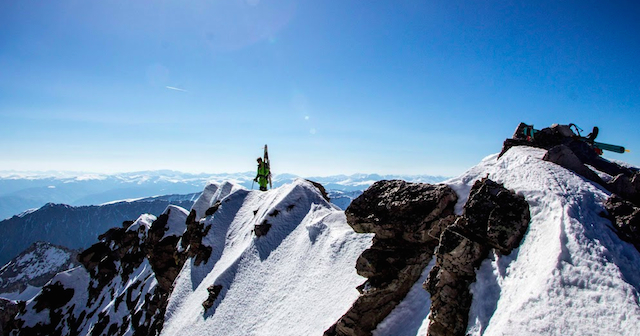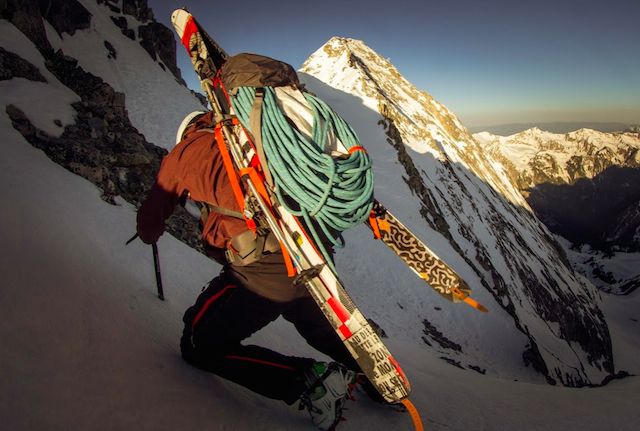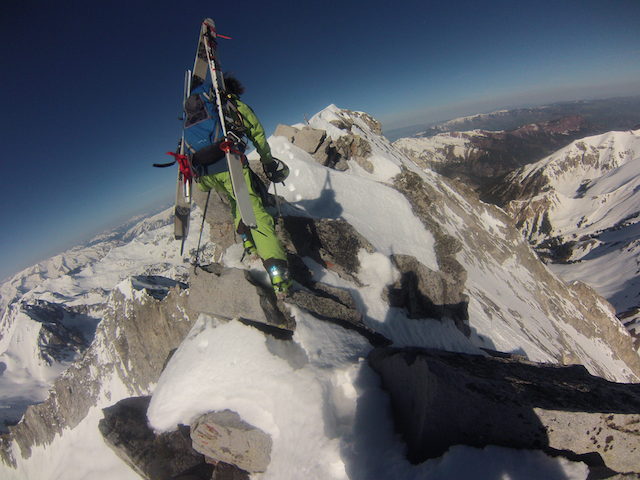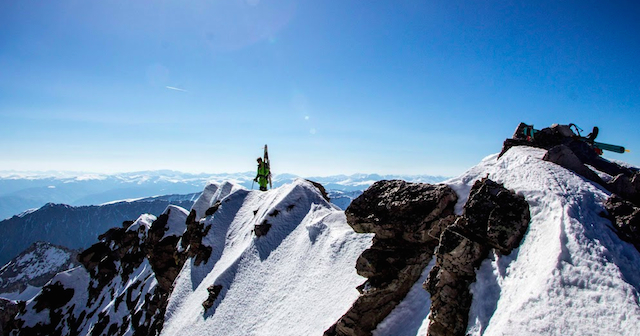tags:
Colter Hinchliffe |
Capitol Peak, Pitkin County, CO, United States |
ski |riley soderquist |peg leg |jordan white |first descent |elk mountains |colter hinchliffe |capitol peak |aspen |14er
 Capitol Peak looming in the distance. @jawsss photo.
Capitol Peak looming in the distance. @jawsss photo.
You’re in over your head. You reach the summit after a midnight start, a headlamp hike, a tedious skin, and a final, fall-you-die scramble, only to realize that there are no safe routes down.
Your intended line isn’t skiable from the top, and your anchor options for rappels are unreliable and crumbly. That, and there are no previous tracks or even another route to follow. Four hours later–having had to change plans multiple times, search desperately for rock stable enough to put a rappel anchor into, and even having lost a ski over a 400-foot cliff–you find yourself on the far side of a terrifying experience, with a first descent, Peg Leg on Colorado's Capitol Peak, now on your skiing resume.
 Necessary gear for a first descent. @jawsss photo.
Necessary gear for a first descent. @jawsss photo.
After an unusually wet May, Aspen locals Colter Hinchliffe, a TGR athlete, Jordan White, and Riley Soderquist made the push for a first descent off of the 14,130-foot summit of Capitol Peak. The chosen line–a multi-rappel, sixty-degree slope with barely six inches of snow on it–is unrecognizable to the non-mountaineer or skier, so much so that even the red marked line in photos seems to be mis-marked.
RELATED: Colter Hinchliffe's 2013 Co-Lab Edit.
So what really happens when you attempt a line that no one’s ever skied? A number of “oh shit” moments, mixed in with some leg shaking adrenaline, and quite a few finger crossings.
How did you choose this line out of a number of difficult lines?
 The line marked here. @jawsss photo.
The line marked here. @jawsss photo.
Me and Jordan White–he was actually the youngest person to ski all of Colorado's 14ers in his early 20's–had been up there before on another first descent on a different line, which wasn't as full on as Peg Leg. We took a scenic flight so we could get some more photos, and we found that there was a more direct route than the Plank that was full of good, clean, white snow. The face is littered with steep snow patches amongst rocks, and if you look at it long enough you can fine those clean routes, and once you see it, it's obvious. It is a really inspiring line.
Can you give me a play-by-play of your day?
 Approaching the summit. @jawsss photo.
Approaching the summit. @jawsss photo.
We shuttled all of our gear–skies, boot, ropes–the day before, so we were able to hike light and fast for the first three miles. That really helped our stamina on the day. Our climb to the top was really exciting, starting with dry trails and nicked snow and booting and some more skinning. We actually had a full moon all night, and just as we started our technical climb, the sun was rising and the moon was falling. We were super exposed, but pretty confident, so we decided not to use ropes even though we were in a no-fall zone.
 A no rope "scramble" to the top. @colterjh photo.
A no rope "scramble" to the top. @colterjh photo.
But once we got closer to the summit and got a closer perspective, we realized that it did not look good… we were in over our heads. We thought we were going to be able to ski in and just traverse over a deep technical section, but when we got up there, we realized we were going to have to rappel over. It was steeper, thinner, rockier, and nastier than we thought it was going to be. I was thinking "Shit, what did we get ourselves into?!?"
 Trying to find a skiiable option down from the summit of Capitol. @colterjh photo.
Trying to find a skiiable option down from the summit of Capitol. @colterjh photo.
We decided, for a moment, that we weren't going to ski it at all. All of our anchor options were really crumbly, and we weren't feeling confident about our rappels. So we went back and forth on the summit trying to find an anchor, and we finally found one we could use.
 The summit of Peg Leg. @jawsss photo.
The summit of Peg Leg. @jawsss photo.
We knew that the normal route was easy, but we couldn't get down that way because it was north facing and in the sun. And then our line off the west had no rock options, so we really had no choice. We remained calm and level-headed, and eventually found a really good rock to rappel in off of. Once we were committed to our line, I felt confident about it. We had to put our fear aside and just do the best we could.
RELATED: When Mitch Tolderer Grabbed Gambler Spine's First Descent.
Rappelling is fine when you're confident in your anchor, but when your anchor fails, you fail. You need to be certain.
This was all before you even began your descent?
 Colter makes rappelling into a line that isn't wide enough to fit two skis, and then pulling all of your rope through your rappel line, look like a walk in the park. @rileysod photo.
Colter makes rappelling into a line that isn't wide enough to fit two skis, and then pulling all of your rope through your rappel line, look like a walk in the park. @rileysod photo.
We rappelled into the first section, and getting off of rappel was really tough. We rapped in with our skis on our back, and once we got over the rock band we had to chisel out a little platform for our skis to sit on, and then pull our skis out of our pack to click in. It was a 60-degree slope (Corbet's Couloir is a mere 50 degrees in comparison) on very thin snow–just about 6 inches of dust on top of rocks. So you're really just relying on your edges. And once I clicked in, I had to pull 400 feet of rope through the rappel line and coil it around my neck.
 Rapelling with skis isn't exactly a walk in the park. @jawsss photo.
Rapelling with skis isn't exactly a walk in the park. @jawsss photo.
This was the spiciest part of our day. It was just a short ski to the next rappel, but it was pretty hard to do carrying the rope on such thin and steep snow. And once we got to the next rappel, we realized that our anchors options were all really crumbly rocks and really unreliable. We just had to wrap webbing around them and hope for the best. It was pretty spooky.
 Colter drops in on "the spiciest part of our day" to the second rappel. @jawss photo.
Colter drops in on "the spiciest part of our day" to the second rappel. @jawss photo.
That rappel got us into the meat of the ski line. It was mid to upper 50's as far as pitch, and we were able to link a couple turns in. But really, the skiing just got us to our next big rappel.
How did you know if you were going to have enough rope to rappel down?
 Skiing the meat of the line. @jawsss photo.
Skiing the meat of the line. @jawsss photo.
This third rappel was really the biggest. It was a huge cliff band, and we weren't sure how many rappels we were going to have to do. It was potentially one, maybe two rappels?
 Rappelling into their line. @jawsss photo.
Rappelling into their line. @jawsss photo.
It was just this huge canyon of rock and snow. And as we were building our anchor, I pulled off my first ski to stuff it in my pack, and then tried to pull off the second one... when it fell. It fell all the way over the 400 foot cliff below us.
So you're mid-descent, mid-mountain, and without a ski? What did you do?
 One ski down but still stoked. @jawsss photo.
One ski down but still stoked. @jawsss photo.
We were essentially done with the technical skiing part, so we could safely get down without a ski. But it was kind of crazy. It just happened so quickly. If we weren't practically done with our ski line, than we would have had to downclimb with our crampons and ice axes. That would have sucked. It's also where we got our name for the line.
At this point, you still have half of your rappels left to get out of your line. How do you manage a rappel when you don't know what you're rappelling into?
 Setting up anchors. @rileysod photo.
Setting up anchors. @rileysod photo.
We had to just throw the ropes down and pray that they hit snow somewhere. They just disappeared out of sight. I went down first, into the unknown, into this chasm. It was like a mini canyon of rock.
RELATED: 5 Tips for Aspiring Ski Mountaineers.
I am the most experienced at building anchors, so I went down with all of the gear. The rock was really good and I was super confident that we were going to be able to put some gear in to build an anchor and re-rappel down, because it was way bigger than just one.
Once I got to the very end of the rope, I equalized it and took myself off rappel and clipped into the anchor I built. Then I had to re-rappel. I had to throw the ropes down again, and I wasn't sure if the ropes were going to be able to make it down all the way, so I just had to bring all the gear down again.
 Rappelling over the cliffband. @colterjh photo.
Rappelling over the cliffband. @colterjh photo.
Once I got over the rock band, I saw that the ropes were touching. I yelled up to Riley and Jordan, hollering that the ropes reached, and once I looked up, there was a rock ripping right past my head.
We had been on the face for nearly four hours at this point, but I realized that it wasn't over yet. Once we got off the rappel, we managed to find the ski at the bottom. It was broken, but not unusable. So I was able to manage the mellow ski down to the very end of our line.
Your line was incredibly technical, both in terms of skiing and climbing. Was it mostly Type II fun?
 Can you spot the one-ski wonder after their final rappel? @ballinbu photo.
Can you spot the one-ski wonder after their final rappel? @ballinbu photo.
It was definitely Type II. The approach and initial climbing were really enjoyable. But the whole time on the face was really scary. I wouldn't want to go back and do it again. But I was super inspired and it was an awesome ascent.
 Looking back at Peg Leg. @rileysod photo.
Looking back at Peg Leg. @rileysod photo.


